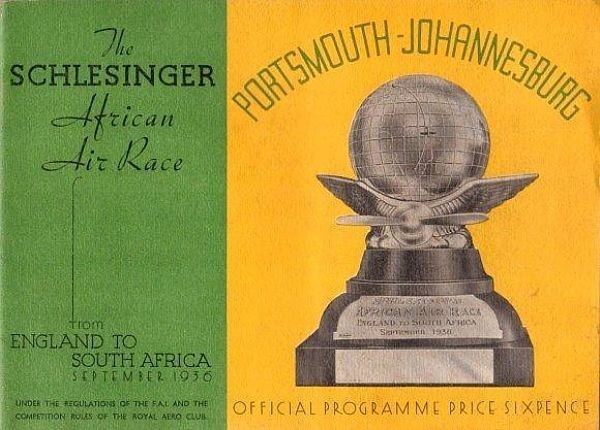 | ||
The Schlesinger Race, also known as the "Rand Race", the "Portsmouth - Johannesburg Race" or more commonly the 'African Air Race', took place in September 1936. The Royal Aero Club announced the race on behalf of Isidore William Schlesinger who wanted to promote the Johannesburg Empire Exhibition and so offered a total of £10,000 in prize money to be divided into two sections, a speed race and a handicap race. The two sections were to be flown concurrently, but no competitor could win both first prizes.
The race was wholly inspired by the very successful 1934 MacRobertson Air Race to celebrate the centenary of the Australian state of Victoria. However, whilst that race was open to all-comers, Schlesinger made the fundamental error of restricting the entry of the Schlesinger Race to British Empire crews and machines only. This led directly to a much smaller entry and only one machine successfully completed the course after many aircraft either failed, crashed or given up. Magazines of the time, such as The Aeroplane and Flight, were suitably scathing. MacRobertson Air Race winner C.W.A. Scott aided by Giles Guthrie won the race in a Percival Vega Gull, but it was a hollow victory, as most of the waiting spectators at Cape Town had given up and gone home by the time he arrived.
Race history
There were 14 entrants, but only nine aircraft took part in the race. Tom Campbell Black was entered into the race in G-EAKL Percival Mew Gull but ten days before the start of the race he was fatally injured at Speke Airport while preparing for the race when Flying Officer Peter Stanley Salter who was the Assistant Adjutant and Chief Flying Instructor of No. 611 Squadron taxiied his Hawker Hart No. K3044 into Black's aircraft which was also taxiing on the runway. Black's fuselage was almost cut in two when the Hart's propeller cut into it, mortally injuring Black, who died in the ambulance in the way to hospital. Two aircraft, Miles Peregrine and M. Chand's Percival Vega Gull were not ready, while John E. Carberry's Vega Gull was damaged when Beryl Markham landed in a peat bog at Balleine Cove, Cape Breton Island, after flying it across the Atlantic Ocean, 4–5 September.
The race began at Portsmouth aerodrome at 6.15 a.m. on Tuesday, 29 September. The winners of the race were C. W. A. Scott and Giles Guthrie. Scott was famous for three England–Australia records and winning the MacRobertson Air Race with Tom Campell Black two years earlier. Scott and Guthrie were flying G-AEKE Percival Vega Gull entered by Giles' father Sir Connop Guthrie and they reached at Rand Airport on 1 October 1936. The aircraft had left Portsmouth 52 hours 56 minutes 48 seconds earlier. Out of the original 14 entries to the race Scott and Guthrie were the only ones to finish, winning the 10,000 pounds prize money.
They covered 6,150 miles at an all in average of 116 m.p.h. and at a flying average of 156.3 m.p.h. When Scott put down at the Rand Airport, Germiston, the Vega Gull was one of the only two machines definitely still in the race, and a few hours later tragedy overtook the other—the Airspeed Envoy flown by Findlay and Waller.
Alington's and Booth's B.A. Eagle had a forced landing near Regensburg in Germany and damaged an undercarriage. A. Miller, flying Percival Mew Gull, had a forced landing before Belgrade and withdrew. Next, T. Rose's B.A.4 Double Eagle got damaged on an airfield in Cairo, due to undercarriage folding. Victor Smith flying Miles Sparrowhawk had problems with oil since Salonika and eventually retired in Khartoum. On 30 September, S. Halse crashed his Percival Mew Gull in a forced landing 20 miles before Salisbury. D. Llewellyn and C. Hughesdon in Percival Vega Gull had a forced landing before Abercorn (today's Mbala), on a shore of Lake Tanganika. In a difficult weather conditions, the Airspeed Envoy crashed during a take off from Abercorn, killing the pilot Maxwell Findlay and radio operator A. Morgan, while Kenneth Waller and the passenger Derek Peachey escaped with injuries. Finally, A.E. Clouston made a forced crash landing 150 miles south of Salisbury in his Miles Hawk Six.
In 1937 Charles E. Gardner went on to win the King's Cup Race in the repaired Mew Gull G-AEKL in which Black had suffered his fatal accident. Guthrie also flew in this race in Vega Gull G-AFAU, finishing in fifth place.
Due to the fact that only one entrant finished the race, Schlesinger suggested that the finishers money which would remain unclaimed should be paid to the dependants of Findlay and Morgan, who met with a fatal accident in the race.
